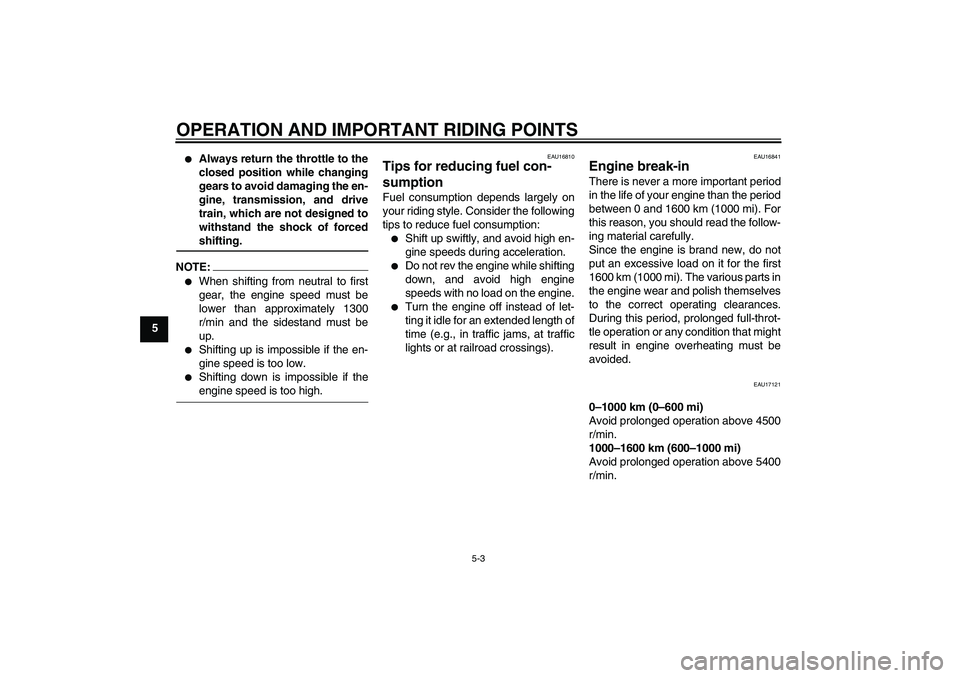Page 24 of 100

INSTRUMENT AND CONTROL FUNCTIONS
3-10
3
CAUTION:
ECA10020
Do not operate the engine if it isoverheated.
Transmission gear display
This display shows the selected gear.
The neutral position, however, is not
displayed, it is indicated by the neutral
indicator light.
To avoid damaging the YCC-S clutch,
the display flashes when it is necessary
to downshift. If this occurs, downshift
until the display stops flashing.Ambient temperature, instanta-
neous fuel consumption and aver-
age fuel consumption modes
(except for the UK)
Push the “RESET” button to switch the
display between the ambient tempera-
ture mode and the fuel consumption
modes in the following order:
Air → km/L or L/100 km → AV_ _._
km/L or AV_ _._ L/100 km → AirAmbient temperature mode
This display shows the ambient tem-
perature from –9 °C to 50 °C in 1 °C in-
crements. The temperature displayed
may vary from the ambient tempera-
ture.NOTE:�
If the ambient temperature falls be-
low –9 °C, a lower temperature
than –9 °C will not be displayed.
�
If the ambient temperature climbs
above 50 °C, a higher temperature
than 50 °C will not be displayed.
1. Transmission gear display
2. Neutral indicator light “”
1. Ambient temperature/instantaneous fuel
consumption/average fuel consumption
2.“SELECT” button
3.“RESET” button
1. Ambient temperature
U2D2EAE0.book Page 10 Monday, June 26, 2006 2:55 PM
Page 54 of 100

OPERATION AND IMPORTANT RIDING POINTS
5-3
5
�
Always return the throttle to the
closed position while changing
gears to avoid damaging the en-
gine, transmission, and drive
train, which are not designed to
withstand the shock of forcedshifting.
NOTE:�
When shifting from neutral to first
gear, the engine speed must be
lower than approximately 1300
r/min and the sidestand must be
up.
�
Shifting up is impossible if the en-
gine speed is too low.
�
Shifting down is impossible if theengine speed is too high.
EAU16810
Tips for reducing fuel con-
sumption Fuel consumption depends largely on
your riding style. Consider the following
tips to reduce fuel consumption:�
Shift up swiftly, and avoid high en-
gine speeds during acceleration.
�
Do not rev the engine while shifting
down, and avoid high engine
speeds with no load on the engine.
�
Turn the engine off instead of let-
ting it idle for an extended length of
time (e.g., in traffic jams, at traffic
lights or at railroad crossings).
EAU16841
Engine break-in There is never a more important period
in the life of your engine than the period
between 0 and 1600 km (1000 mi). For
this reason, you should read the follow-
ing material carefully.
Since the engine is brand new, do not
put an excessive load on it for the first
1600 km (1000 mi). The various parts in
the engine wear and polish themselves
to the correct operating clearances.
During this period, prolonged full-throt-
tle operation or any condition that might
result in engine overheating must be
avoided.
EAU17121
0–1000 km (0–600 mi)
Avoid prolonged operation above 4500
r/min.
1000–1600 km (600–1000 mi)
Avoid prolonged operation above 5400
r/min.
U2D2EAE0.book Page 3 Monday, June 26, 2006 2:55 PM
Page 68 of 100

PERIODIC MAINTENANCE AND MINOR REPAIR
6-13
6wise the engine may not be
sufficiently cooled and the cool-
ing system will not be protected
against frost and corrosion.
�
If water has been added to the
coolant, have a Yamaha dealer
check the antifreeze content of
the coolant as soon as possible,
otherwise the effectiveness ofthe coolant will be reduced.WARNING
EWA10380
Never attempt to remove the radiatorcap when the engine is hot.NOTE:�
The radiator fans are automatically
switched on or off according to the
coolant temperature in the radia-
tor.
�
If the engine overheats, see page6-31 for further instructions.
EAU33030
Changing the coolant
WARNING
EWA10380
Never attempt to remove the radiatorcap when the engine is hot.
The coolant must be changed at the in-
tervals specified in the periodic mainte-
nance and lubrication chart. Have a
Yamaha dealer change the coolant.
EAU40370
Air filter element The air filter element must be cleaned
and replaced at the intervals specified
in the periodic maintenance and lubri-
cation chart. Have a Yamaha dealer
clean and replace the air filter element.
U2D2EAE0.book Page 13 Monday, June 26, 2006 2:55 PM
Page 87 of 100

PERIODIC MAINTENANCE AND MINOR REPAIR
6-32
6 Engine overheating
WARNING
EWA10400
�
Do not remove the radiator cap when the engine and radiator are hot. Scalding hot fluid and steam may be
blown out under pressure, which could cause serious injury. Be sure to wait until the engine has cooled.
�
After removing the radiator cap retaining bolt, place a thick rag, like a towel, over the radiator cap, and then
slowly rotate the cap counterclockwise to the detent to allow any residual pressure to escape. When the hissingsound has stopped, press down on the cap while turning it counterclockwise, and then remove the cap.
NOTE:If coolant is not available, tap water can be temporarily used instead, provided that it is changed to the recommended coolantas soon as possible.
Wait until the
engine has cooled.
Check the coolant level in the
reservoir and radiator.
The coolant level
is OK.The coolant level is low.
Check the cooling system
for leakage.
Have a Yamaha dealer checkand repair the cooling system.Add coolant. (See NOTE.)
Start the engine. If the engine overheats again,
have a
Yamaha dealer check
and repair the cooling system.
There is
leakage.
There is
no leakage.
U2D2EAE0.book Page 32 Monday, June 26, 2006 2:55 PM